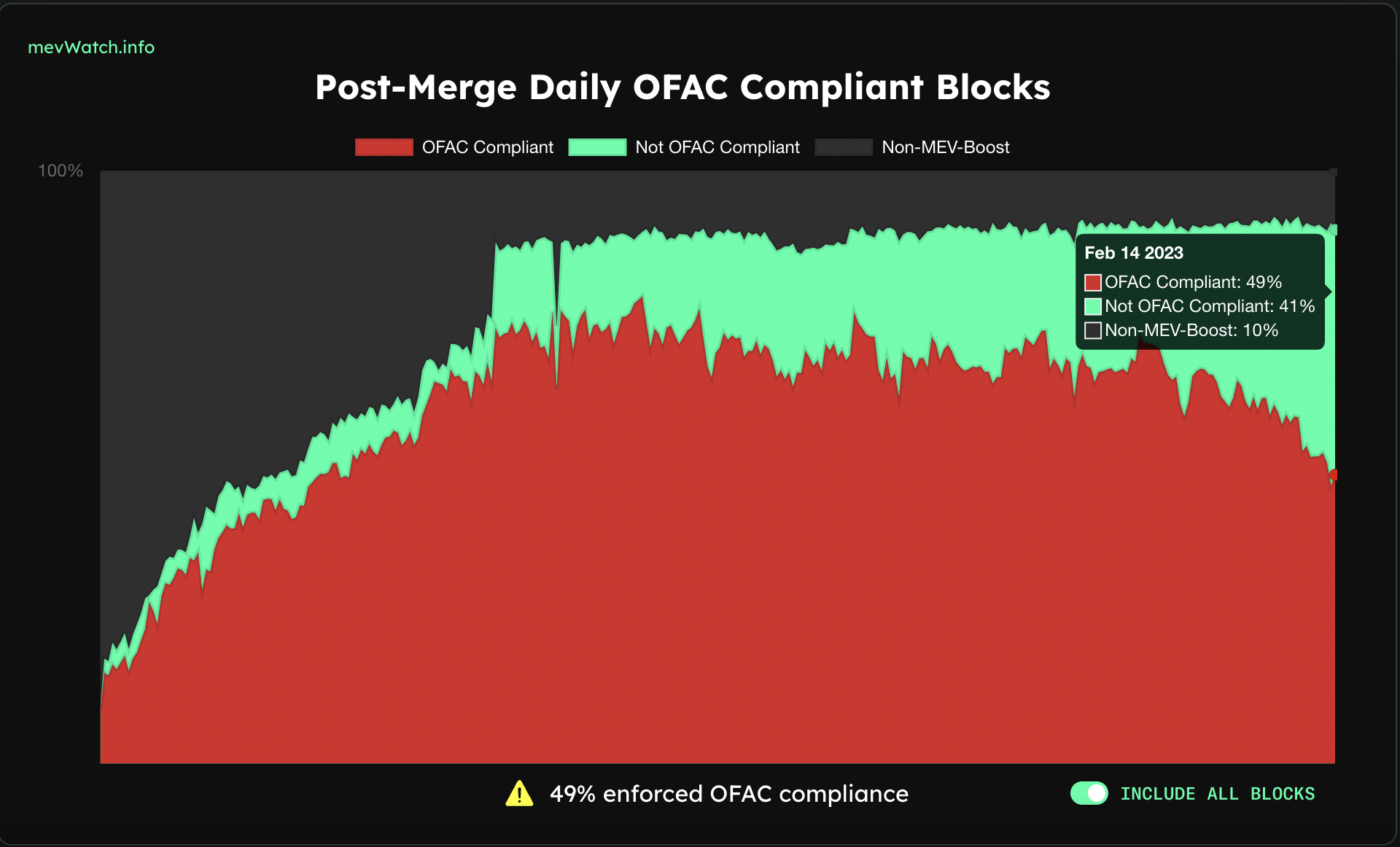After the U.S. government blacklisted Tornado Cash transactions for U.S. people in August, there was a swift response by validators on the Ethereum blockchain to exclude sanctioned transactions. For many in the crypto industry, such moves were decried as censorship – directly counter to the vision of a decentralized network free from government interference.
Now, however, the trend is going the other way, and more blocks with Tornado Cash are going through even if they’re not compliant with U.S. Treasury Dept. sanctions.
According to an MEV watchdog site, just 49% of blocks that made it onto the Ethereum blockchain over the past 24 hours were OFAC-compliant, meaning the blocks excluded transactions that have been sanctioned by the U.S. Treasury Department’s Office of Foreign Assets Control.
This is a significant decrease in censorship from Ethereum’s past. Ethereum hit an all-time high for censorship on Nov. 21, when 79% of blocks relayed on Ethereum excluded OFAC-sanctioned transactions. The last time that Ethereum’s censored blocks were below 50% was Oct.16.
Put another way, that means that more than half of the blocks that made it onto the Ethereum blockchain over the last 24 hours are non-OFAC compliant.
So what has reversed Ethereum’s censorship course?

Post-Merge OFAC Compliant Blocks (mevwatch.info)
MEV-Boost contributed to Ethereum’s censorship problem
Since Ethereum changed its consensus mechanism to proof-of-stake in September (known as the Merge), most of the blocks that make it onto the blockchain go through a middleware component known as MEV-Boost, which is a software that allows validators to request pre-made blocks from builders.
MEV-Boost came into existence to help validators earn MEV, or Maximal Extractible Value, which are profits derived from including or reordering transactions within a block.
The software was built by Flashbots, an Ethereum research and development team, in order to democratize MEV among validators and skirt issues of centralization.
Flashbots has succeeded in having MEV-Boost used across the ecosystem, as 96% of validators today have relayed blocks via the middleware. The firm also runs its own relayer, which is used by 68% of validators.
But a new set of issues, mainly censorship, arose with MEV-Boost after OFAC blacklisted Tornado Cash transactions for U.S. people in August.
As a result of the sanctioning, relayers using MEV-Boost deliver to their connected validators only pre-built blocks without Tornado Cash transactions included. In other words, MEV-Boost was censoring blocks by default.
Has the censorship course reversed?
The push for validators to connect to other relayers that are not Flashbots’ has been at the center of reversing Ethereum’s censorship course.
Today, 68% of blocks relayed have been done via Flashbots. As recently as December, that number was at 74%. Before Flashbots began censoring Tornado Cash transactions following the Merge, it open-sourced the code so that others could develop their own non-censoring relays.
There are now seven relayers that are noncensoring. Those include two of BloXroute’s relayers (max profit and ethical), Ultrasound, Agnostic Gnosis, Manifold, Relayoor and Aestus.

Relayers and total market share (mevboost.pics)
Martin Köppelmann, a censorship-resistance advocate and the co-founder of Gnosis Chain, which also runs a noncensoring relayer, shared in a tweet that the decline in censorship is partially thanks to BloXroute, Ultrasound and Gnosis since they make up most of the uncensored block space.
Köppelmann told CoinDesk that he believes this “is good news and I am happy Gnosis is contributing, but I also believe Ethereum censorship resistance should not depend on so few entities.”
Learn more about Consensus 2023, CoinDesk’s longest-running and most influential event that brings together all sides of crypto, blockchain and Web3. Head to consensus.coindesk.com to register and buy your pass now.